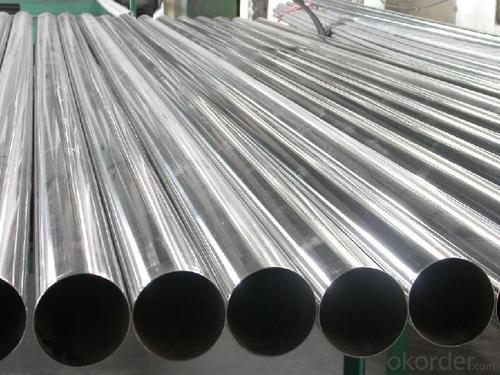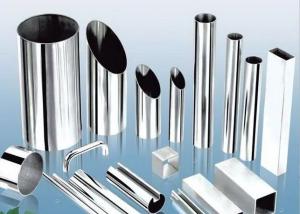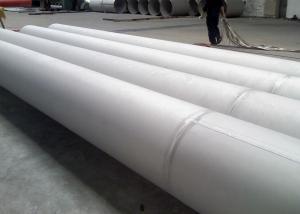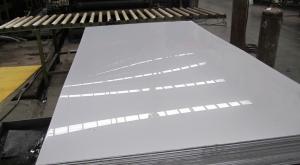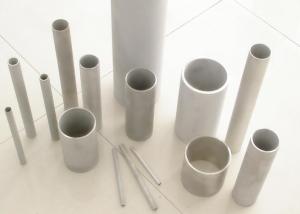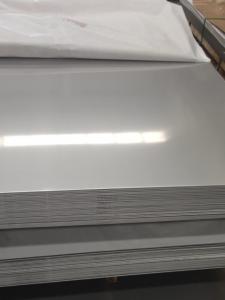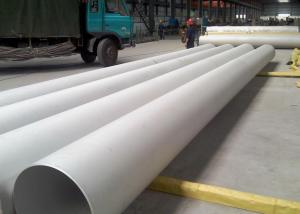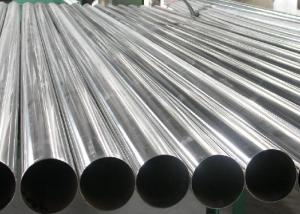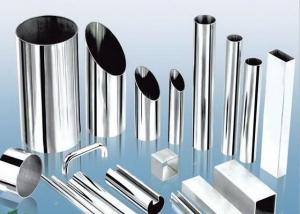Best Price For Stainless Steel Welded Pipe 304
- Loading Port:
- China Main Port
- Payment Terms:
- TT or LC
- Min Order Qty:
- 5 Tons m.t.
- Supply Capability:
- 1000 ton per month m.t./month
OKorder Service Pledge
OKorder Financial Service
You Might Also Like
Best Price For Stainless Steel Welded Pipe 304
Stainless steel is a production which not easy rust,acid resistance and corrosion resistance,so it is widely used in light industry,heavy industry,daily necessities and the decoration industry.my company long-term supply stainless steel porducts including:stainless steel sheet,stainless steel coil and stainless steel tube
General Information Of Best Price For Stainless Steel Welded Pipe 304
Thickness | 0.5~50mm | |||||||
OD | 6~2020mm | |||||||
Standard | ASTM,AISI,JIS,GB,DIN, etc. | |||||||
Chemical Composition(%) | C | Mn | P | S | Si | Ni | Cr | N |
≤0.08 | ≤2.00 | ≤0.045 | ≤0.030 | ≤0.75 | 8.00~10.50 | 18.00~20.00 | ≤0.10 | |
Surface | 2B, BA, 8K,etc. | |||||||
Technique | Cold/Hot Rolled | |||||||
Certification | ISO | |||||||
Package | Standard export packing or as your request | |||||||
Application | Used in machine, auto, bike, furniture, hotel decoration, etc. | |||||||
Advantages | 1. Corrosion resistance. 2. High temperature resistance. 3. High production ability. 4. Reasonable price. 5. Excellent quality. 6. Various sizes. | |||||||
Main Market | North America, South America, Europe, Southeast Asia, Africa, Oceania, Middle East, Eastern Asia, Central America | |||||||
Delivery Time | Within 15 days | |||||||
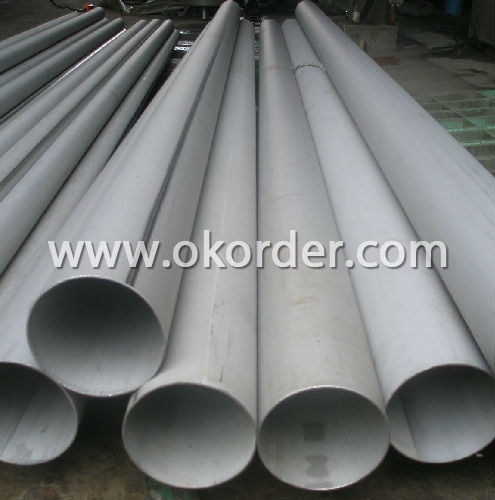

- Q: How do you prevent crevice corrosion in stainless steel sheets?
- One common method to prevent crevice corrosion in stainless steel sheets is by ensuring proper sealing and avoiding the formation of stagnant crevices. This can be achieved by using gaskets or sealants to seal any gaps or joints where moisture can accumulate. Additionally, regular cleaning and maintenance to remove any deposits or contaminants that could promote corrosion is essential. Using stainless steel with higher alloy content or corrosion-resistant coatings can also provide added protection against crevice corrosion.
- Q: How do I prevent galvanic corrosion on stainless steel sheets?
- To prevent galvanic corrosion on stainless steel sheets, there are several measures you can take: 1. Ensure proper alloy selection: Choose a grade of stainless steel that is less prone to galvanic corrosion. Grades such as 316 and 317 are more resistant to corrosion compared to 304 stainless steel. 2. Separate dissimilar metals: Avoid direct contact between stainless steel sheets and other metals, especially those with a higher potential for galvanic corrosion. If contact is necessary, use insulating materials such as gaskets or rubber pads to separate the metals. 3. Use protective coatings: Apply protective coatings or paints specifically designed for stainless steel to create a barrier and prevent galvanic corrosion. These coatings act as a sacrificial layer, shielding the stainless steel from direct contact with the corrosive material. 4. Use isolation materials: Install insulating materials between stainless steel sheets and other dissimilar metals. These can include plastic washers, insulating tape, or non-conductive gaskets to prevent direct electrical contact and subsequent corrosion. 5. Proper maintenance: Regularly clean and inspect stainless steel sheets to remove any contaminants or foreign substances that could promote corrosion. Avoid using abrasive cleaners or tools that could damage the protective layer of the stainless steel. 6. Electrochemical protection: Implement cathodic protection techniques, such as using sacrificial anodes or impressed current systems, to provide an external source of electrons that can counteract galvanic corrosion. These methods help shift the corrosion potential of the stainless steel sheets to a more passive range. By following these preventive measures, you can significantly reduce the risk of galvanic corrosion on stainless steel sheets, ensuring their longevity and maintaining their structural integrity.
- Q: What are the main chemical constituents of stainless steel plates?
- Stainless steel not only refers to a stainless steel, but more than one hundred kinds of industrial stainless steel, the development of each kind of stainless steel in its specific application areas have good performance. The key to success is to find out what the purpose is, and then determine the correct type of steel. There are usually only six kinds of steel related to the application of building construction. They all contain 17 to 22% chromium, and better steel also contains nickel. The addition of molybdenum can further improve atmospheric corrosion, especially for atmospheric corrosion resistant chlorides.
- Q: Are stainless steel sheets suitable for water tanks?
- Yes, stainless steel sheets are suitable for water tanks. Stainless steel is highly resistant to corrosion and rust, making it an ideal material for water storage. It is durable, long-lasting, and can withstand high water pressures. Additionally, stainless steel is hygienic, easy to clean, and does not contaminate the water.
- Q: How long do stainless steel sheets last?
- Stainless steel sheets are renowned for their durability and long-lasting nature. The lifespan of these sheets can vary depending on factors like the grade and quality of the stainless steel, environmental conditions, and maintenance practices. However, with proper care and normal circumstances, stainless steel sheets can endure for many decades or even a lifetime. The longevity of stainless steel is greatly influenced by its ability to resist corrosion. This is made possible by the presence of chromium, which forms a passive layer on the surface of the material, safeguarding it from rust and corrosion. This natural protective layer enables stainless steel sheets to withstand harsh environmental conditions, including exposure to moisture, chemicals, and extreme temperatures. Moreover, the grade of stainless steel also plays a role in its lifespan. There are different grades available, such as 304, 316, and 430, each offering varying levels of corrosion resistance. Higher grades, particularly 316 stainless steel, exhibit greater resistance to corrosion and are commonly used in marine and highly corrosive environments, ensuring a longer lifespan. To maximize the lifespan of stainless steel sheets, proper maintenance is crucial. Regular cleaning with mild detergents and non-abrasive materials is necessary to eliminate dirt, grime, and contaminants that can degrade the protective layer of stainless steel. Additionally, it is important to avoid contact with harsh chemicals or abrasive materials that can scratch or damage the surface. While stainless steel sheets have an impressive lifespan, it is important to acknowledge that their durability is not limitless. Over time, factors like wear and tear, exposure to severe conditions, or improper maintenance can gradually diminish the protective layer of stainless steel and reduce its lifespan. Nonetheless, with appropriate care and maintenance, stainless steel sheets can be a cost-effective and enduring choice for various applications, including construction, automotive, and household products.
- Q: Can stainless steel sheets be used for food packaging equipment?
- Yes, stainless steel sheets can be used for food packaging equipment. Stainless steel is a common material choice for food packaging equipment due to its durability, corrosion resistance, and hygienic properties. It is able to withstand the rigorous demands of food packaging processes and ensure the safety and quality of the packaged food.
- Q: How do you prevent staining on stainless steel sheets?
- To prevent staining on stainless steel sheets, there are several measures you can take: 1. Regular cleaning: Clean the stainless steel sheets regularly using mild soap or detergent and warm water. Avoid using harsh chemicals or abrasive cleaners that can damage the surface. 2. Avoid exposure to corrosive substances: Keep stainless steel sheets away from corrosive substances such as bleach, ammonia, and acidic cleaners. If accidental spills occur, immediately rinse the affected area with water and thoroughly dry it. 3. Use a protective coating: Apply a protective coating or film on the stainless steel sheets to create a barrier between the surface and potential staining agents. There are various protective products available specifically designed for stainless steel, such as protective sprays or polishes. 4. Proper maintenance: Regularly inspect the stainless steel sheets for any signs of damage, scratches, or rust. Promptly address any issues by cleaning or repairing the affected areas to prevent staining. 5. Avoid abrasive materials: When cleaning or maintaining stainless steel sheets, use soft cloths or non-abrasive sponges to avoid scratching the surface. Avoid using steel wool or abrasive materials that can leave marks or damage the stainless steel. 6. Dry thoroughly: After cleaning the stainless steel sheets, ensure they are thoroughly dried to prevent water spots or mineral deposits from forming. Use a clean, lint-free cloth to wipe away any moisture. 7. Handle with care: Be mindful of how you handle stainless steel sheets to prevent scratching or damaging the surface. Avoid dragging or sliding heavy objects across the sheets, as this can leave marks or cause abrasions. By following these preventive measures, you can maintain the appearance and integrity of stainless steel sheets and minimize the risk of staining.
- Q: What are the advantages of using stainless steel sheets in the medical industry?
- There are several advantages of using stainless steel sheets in the medical industry. Firstly, stainless steel is highly resistant to corrosion, making it a durable and long-lasting material for medical equipment and instruments. This resistance to corrosion is crucial in maintaining sterile conditions and preventing the growth of bacteria or other harmful microorganisms. Additionally, stainless steel is easy to clean and sanitize, reducing the risk of cross-contamination. It is also non-reactive, meaning it does not release any harmful substances or chemicals into the medical environment. Lastly, stainless steel has a high strength-to-weight ratio, making it ideal for constructing lightweight yet sturdy medical devices. Overall, the use of stainless steel sheets in the medical industry ensures safety, hygiene, and reliability.
- Q: Are stainless steel sheets suitable for railway applications?
- Stainless steel sheets prove to be a fitting option for railway applications. They possess exceptional resistance to corrosion, rendering them perfect for utilization in settings constantly exposed to moisture, chemicals, and other harsh circumstances, such as railway tracks. Furthermore, these sheets exhibit notable strength and durability, essential qualities for enduring heavy loads and vibrations associated with railway operations. The material also showcases commendable heat resistance, enabling it to maintain its structural integrity even in high-temperature environments like railway brakes. Moreover, stainless steel sheets can be effortlessly molded and fabricated into diverse shapes and sizes, making them adaptable for various railway components such as cladding, paneling, and structural elements. All in all, stainless steel sheets offer a dependable and enduring solution for railway applications, ensuring the safety and performance of railway infrastructure.
- Q: What are the different types of stainless steel sheet finishes for sanitary applications?
- For sanitary applications, various types of stainless steel sheet finishes are commonly used. These finishes are specifically designed to offer a smooth and clean surface that resists corrosion and bacteria growth. 1. One commonly used finish for stainless steel sheets in sanitary applications is the #4 Brushed Finish. It presents a brushed appearance that creates a consistent and uniform texture. This finish is easy to clean and maintain, making it perfect for environments where hygiene is of utmost importance. 2. Another option is the #8 Mirror Finish, which boasts a highly reflective surface resembling a mirror. It is visually appealing and easy to clean due to its smooth and shiny nature. However, it is worth noting that this finish may show scratches and fingerprints more readily than others. 3. The 2B Finish is generally applied to stainless steel sheets that will undergo further processing, such as fabrication or welding. It presents a dull and smooth appearance, providing a suitable base for additional treatments or coatings. 4. The Satin Finish, also known as a No. 4 finish, offers a low luster and smooth texture. It is frequently used in sanitary applications where a clean and aesthetically pleasing surface is desired. 5. A Bead Blast Finish is achieved by subjecting the stainless steel sheet to fine glass beads. This process results in a non-reflective surface that is uniform and easy to clean. It also provides resistance to corrosion, making it a popular choice for food processing plants and pharmaceutical facilities. 6. Lastly, the Electropolished Finish involves an electrochemical process that removes a thin layer from the stainless steel surface, leaving behind a smooth and shiny appearance. This finish offers a high level of cleanliness and resistance to corrosion, making it suitable for sanitary applications in the pharmaceutical and biotech industries. To ensure the best possible outcome, it is crucial to consider the specific requirements of the sanitary application when selecting the appropriate stainless steel sheet finish. Factors such as corrosion resistance, ease of cleaning, and aesthetic appearance should be taken into account.
1. Manufacturer Overview
| Location | Zhejiang,China |
| Year Established | 2000 |
| Annual Output Value | Above US$8.3 Million |
| Main Markets | Europe, America |
| Company Certifications | ISO9001:2000 |
2. Manufacturer Certificates
| a) Certification Name | |
| Range | |
| Reference | |
| Validity Period |
3. Manufacturer Capability
| a) Trade Capacity | |
| Nearest Port | Shanghai |
| Export Percentage | 30% |
| No.of Employees in Trade Department | 30 People |
| Language Spoken: | English;Chinese |
| b) Factory Information | |
| Factory Size: | Above 80,000 square meters |
| No. of Production Lines | Above 7 |
| Contract Manufacturing | OEM Service Offered;Design Service Offered |
| Product Price Range | Average |
Send your message to us
Best Price For Stainless Steel Welded Pipe 304
- Loading Port:
- China Main Port
- Payment Terms:
- TT or LC
- Min Order Qty:
- 5 Tons m.t.
- Supply Capability:
- 1000 ton per month m.t./month
OKorder Service Pledge
OKorder Financial Service
Similar products
Hot products
Hot Searches
Related keywords





